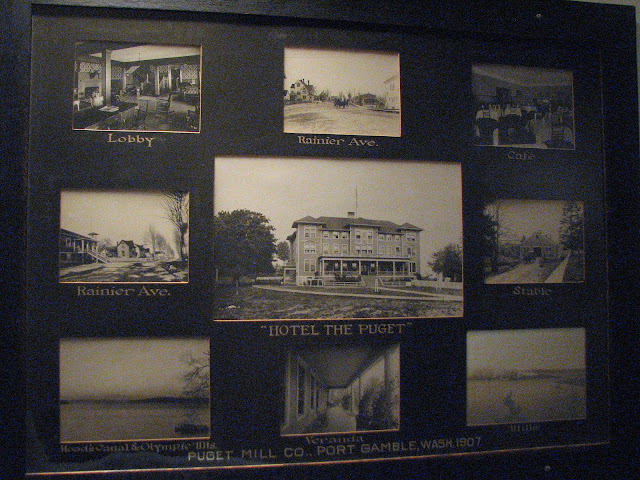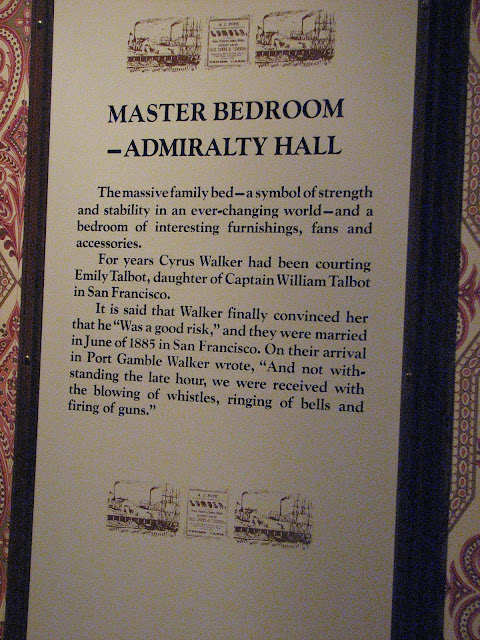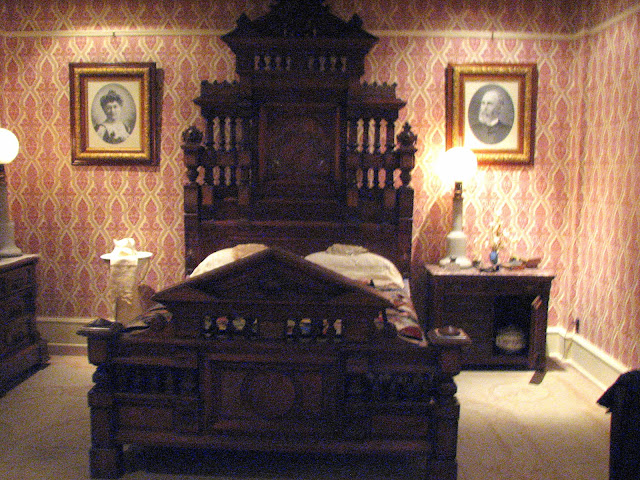Check out our previous entries: PORT GAMBLE HISTORY and HISTORIC PORT GAMBLE featuring our walk through the town and the history posted around town.
The Port Gamble Museum is located down the hill in the basement area of the General Store & Cafe. It was extremely interesting for me because in my hometown (Eau Claire, WI) ... there is a Pope & Talbot (or at least that's what it was when I was growing up, it's still there - but it was bought out.) ... anyway - so I had no idea that Pope & Talbot had originated here. It was interesting to me ...
LARGE ANCHOR .. this anchor came from the sunken lumber schooner "War Hawk". It was found 200 feet from the hull in Discovery Bay.
GRINDSTONE - This grindstone was used in the mill until 1895 when it was given to Knute O. Vaa by Cyrus Walker when Knute retired. It was then donated by Edwin Vaa at the time of his fathers death.
WORTHINGTON DEPLEX PUMP - Steam driven water pump used in Port Gamble Sawmill from 1913 to 1974. It supplies high pressure water to all the plant and townsite fire hydrants.
Inside the Museum.
SPRINGBOARD - Often, trees of the West were so large at their base that in order to fell them, a springboard was necessary to elevate a logger to a higher and narrower portion of the tree trunk. The springboard was wedged into a notch chopped into the trunk of the tree and was supported by a metal lip, which anchored it firmly into the upper wood of the notch.
CLIMBING IRONS - These sturdy irons fit under the foot of the logger and were strapped to the leg at the ankle and below the knee. Equipped with sharp spurs, the climbing iron aided the logger in climbing a tree.
 |
| Captain's Cabin |
CAPTAIN'S CABIN ABOARD THE ORIENTAL - This cabin was home to Captain Talbot on his long voyage to Puget Sound, and was relatively comfortable in heavy seas. Men tended to be somewhat shorter 125 years ago, thus the lack of head room in the cabin.
Like most mariners of the period, the captain's cabin contained an unusual array of tools, bedding, clothing, utensils, and furniture. Greatly important was the ship's sextant for determining direction by shooting the sun and stars, as was the teltale compass positioned above the Captain's bunk.
CAPTAIN WILLIAM C. TALBOT * 1816-1881 * Captain William C. Talbot became a principal partner in the new enterprise and his extensive seafaring experience contributed much to the Company's successful growth.
It was Captain Talbot along with Cyrus Walker, another down-Easterner, who built the first sawmill at Port Gamble in 1853.
CARGO HOLD OF THE ORIENTAL - In this small ship Captain Talbot carried enough lumber to construct temporary facilities for his men while they built the new sawmill at Port Gamble.
In addition, the ORIENTAL carried tools, foodstuffs, and items suitable for trading with the local Indians.
The large basket was the principal means of transporting cargo from the ship's hold to shore.
HOWITZER BALL - U.S. STEAMER MASSACHUSETTS - This iron Howitzer ball has been traced back to the historic time when America suffered its first naval casualty in the Pacific.
Gustave Englebrecht, coxswain aboard the U.S. Steamer Massachusetts, was fatally wounded by a northern Indian iron slug during a major Indian uprising on November 21, 2856. His grave is located in the Port Gamble cemetery.
The howitzer ball was given to Henry Cotter, a mill tallyman by an Indian from the Little Boston community in 1910. The Indian was chopping firewood from a cedar log when the ball rolled out of a split piece of wood.
LOG OF THE U.S. STEAMER "MASSACHUSETTS" - PORT GAMBLE - NOVEMBER 21, 1856
Commences with and until 4 (AM) calm, and overcast. Later part, fresh North winds, clear and pleasant. Signed G. Howard. Act-g. M. Mate
From 4 to 8, fresh N.W. winds, clear and pleasant weather. At 6 hr. 40 m. Lieut. Stemmes, left the ship in the 1st Cutter, with the crew armed, for the Steamer "Traveller". At 7 hr 10 m an armed force, composed of 39 sailrs and Marines from the "Traveller" with the Launche's Howitzer landed under the command of Lieut. Stemmer, accompanied by Lieut. Forrest and Mr. Fendall, Commander Clerk. Act. M. Mate J.C. Cumin remaining aboard of the "Traveller" with four men and the "Field Piece". Got a Kedge and Hawser, out astern and sprung the ships, Port Vattery, on the "Indian Camp".
At 7 hr 20 m the force onshore opened fire on the "Northern Indians", also the Steamer "Traveller", and the Ships Port Battery, which was returned by the Indians.
In the engagement, Gustave Englebrecht (coxwain) was mortally wounded, by an Iron Slug, in the right temple, and died shortly afterwards. James Collins, (seaman) was wounded in the Vale of the leftthumb, by a laden slug.
The party under Command of Lieut. Semmes, landed in a very heavy swell up to their waists in water, carrying the Launches Howitzer, in their arms, and charged the "Indians" in a very gallent manner. Setting fire to their encampment destroying propery to the amount of several thousand dollars and disabling all of their canoes but one. Signed A. Tyler - Actg Boatswain
From 8 to Meridian, light of the N.W. breezes, and cloudy. At 10 hr 30 m ceased firing, from shore, onboard ship and from the Traveller. At 10 hr 45 m the forces returned onboard, in the Traveller having the Launch and 1st Cutter in tow; Hoisted the Field Piece, onboard from the Steamer "Traveller" it being disabled and replaced it by the Launches Howitzer. At 12 H hove up the anchor and stood further in. Signed A. W. McIpine - Actg Gunner
These items were on display.
38 STAR AMERICAN FLAG - While the exact origin of this particular flag is uncertain, it appears this version of Old Glory flew over the mills at Port Gamble and Port Ludlow between the years of 1876 and 1890. It was hand sewn by "Granny" Craig, wife of a Port Gamble sawmill foreman, and later given to James Kiefer, and early attorney for the Puget mills.
This flag was graciously donated by Mr. Edna Keifer Fergunson, daughter of James Kiefer.
SAW FILLING ROOM - Playing a key role in saw milling are the master craftsmen known as saw filers. This represents a saw filing room at Port Gamble in the early 1900s. Displayed is a small anvil, used for tensioning and straightening circular saws, a circular saw grinder, and a band saw grinder which is set up for, and will be in actual use when needed.
SAN FRANCISCO LUMBER SALES OFFICE - On December 3, 1849, A.J. Pope, Fredrick Talbot, Captain J. P. Keller and Lucius Sanborn started business under the original name of Pope & Talbot. Fundamental to the commerce of San Francisco in the 1850's were two things best known to Pope & Talbot - ships and lumber. While Talbot took care of the shipping part of the business, Pope handled all sales and merchandising from this office at the corner of Pine and Battery Streets in downtown San Fransisco. Pope was so successful at selling lumber that he kept his seafaring partner Talbot almost continuously at sea bringing lumber from the Puget Sound to their San Francisco sales yard.
MYSTERIES OF WOOD ... The unusual collection of "modern" fossils aptly demonstrates Nature's adaptability as well as the havoc it occasionally brings to sawmills. Glass insulators, iron spikes, barbed wire - these and other elements of man over the years have found their way into the growth of trees. In many cases, they remain undiscovered until met by the high-speed sawmill blade. The shattered, twisted result is vivid testimony to the violence of the meeting.
In this picture you can see the window on the far wall - there will be a picture of that later on....
A drawing of Port Gamble back in the day ...
STREETS OF SAN FRANCISCO ... From A. J. Pope's office this is how San Francisco appeared to Pope & Talbot in the early 1850's. San Francisco was building to serve the miner's search for gold in the nearby Sierras. With the boom, came the derelicts and criminals. Talbot described the area immediately across the block as a den of robbers and desperado It was a "Lovely and desolate spot even in the daytime, and at night a place to be avoided."
The Puget Hotel
Some photos .....
MRS. J.P. KELLER... She and her daughter were the first white women to visit Port Gamble site. Later she sent out Maple tree slips from E. Machias, Maine that became huge trees that shade Port Gamble streets today.
CAPTAIN J.P. KELLER... Original partner in Puget Mill Company. Brought first mill machinery from Boston, Mass. in schooner "L. P. Foster." First manager of Pope & Talbot Mill.
Kaedyn, Nathan, Noah and Ivy ... unhappily posing for a pic.
Okay - from now on I'm not going to write it out if it's easy to read :)
The Indian House display is below ...
This was a display about planting trees and the Forest Research Center...
Photo timeline going back in history ....
Maps
Documents
The Library
Noah taking a seat in the "library" ...
HAND CARTS ... 1800s - Early 1900s ... This hand cart was used by the dock repairman (called 'wharf rats') to haul tools, timber, nails, etc. for repairing the mill dock. They also had larger carts which were pulled by horses until the arrival of the electric jitney and later the gas jitney.
















































































































No comments:
Post a Comment